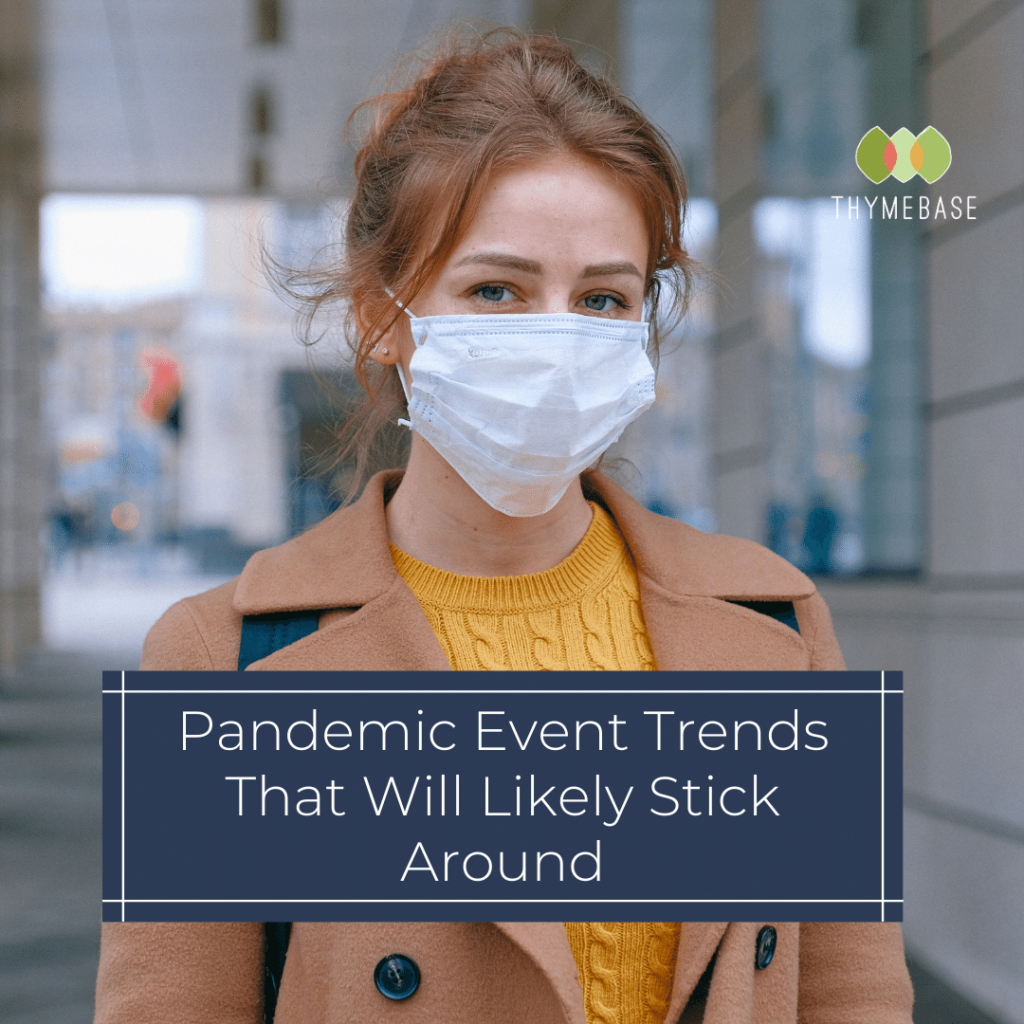Is there really a new normal? I believe some pandemic event trends will have a lasting effect on the event industry.
The United States has been in and out of some sort of stay-at-home order since the middle of March 2020. While there is now news of viable vaccines, things probably won’t return to “normal” for at least 6-12 months.
But people want to get together. Companies want to launch new products for their faithful clients. Couples want to get married and celebrate with their friends and families. Events will happen. They just won’t happen exactly as they did before. Here are some pandemic event trends that will be here to stay for quite some time.

Related: 2021 Event Decor Trends Are Downsized & Intimate
Hybrid Events Are Going To Be Common
You have probably participated in a few digital events that you would not have even imagined possible the year prior during the past few months. I’ve been to online funerals, a virtual class reunion, and online graduations, just to name a few. Some of these events may stay entirely online, but I think in the future that many will be a mix of both in-person and virtual.
A funeral is a good hybrid event example. In the case of a loved one’s death, sometimes it is just not possible to attend a funeral in person. Having the option to watch online will help people grieve who cannot be there in person, but it will also add an extra dimension to the planning. Pandemic event trends mean that event planners will have to consider the needs of both those who are there in person and those attending virtually.
This means you should find and retain an audio/visual expert. This person should also be experienced in streaming and know what platform is appropriate for your specific event type. Streaming a speech or lecture requires different technology than a conference.
Also, keep in mind that there will be a mix of prerecorded and live audio and visual for some events. Make sure anything prerecorded is easily accessible for your attendees. For a book club, there may be a speech from the author that attendees must view beforehand or be asked to watch together before discussing their book.
Single Serving Everything
This pandemic event trend pains me because it tends to be very environmentally unfriendly. Almost everything you will be touching at an in-person event will be single-use. That means having a pen for every person signing in. There will be fewer buffets. And no more thermos of milk and a bowl of sugar at the coffee station. There may not even be ceramic mugs and metal spoons.
This definitely means more garbage and a need for personal protective equipment for garbage handlers. It also may increase costs. Until we can be sure that the pandemic is on the verge of eradication, this will be the new normal.
However, you can use this to your advantage and consider it a branding exercise. Facemasks are always useful, so why not put your logo on them? Search for delicious prepackaged snacks that really show your values (local, sustainable, fair trade, minority-owned, etc.).
Space Size Will Matter
A few years ago, I went to a wedding held at a hotel rooftop in New York City. It was very cozy. The space was so narrow that there was only enough room for three seats on each side of the aisle. Kind of like an airplane, except I had more legroom on my flight there.
Clients are demanding bigger spaces. There won’t be much rubbing shoulders at cocktail bars in the near future. The intimate spaces you favored in the past will now be for a smaller, more sparse crowd. You will need to find bigger, more open spaces to have your guests feel comfortable attending your event.
Along these same lines, how you seat people, especially at events where food is served, will change. A table for 10 may need to become a table for 6 or even 4. This will require you to design your seating in ways that are different from before. Luckily, many floorplan design tools have “social distancing” features built-in now.
Contactless Interactions Are Here To Stay
I recently went to an outdoor restaurant where the menu changed every day. However, no menus were ever printed. At the start of the meal, a waiter came by our table with a tablet with a QR code to view the daily menu on our phones. For those who were not adept at technology, a disinfected tablet was provided to view the menu.
Since most people are currently walking around with internet-connected mini-computers in their pockets, it is easy for them to access all the information they need.
This includes how you plan events. You need to be on the lookout for ways to digitize how you plan to minimize face to face interactions. Figure out how to accept more digital payments rather than using checks or cash. Using a shared platform like Thymebase can keep your to-dos and timelines in order. Schedule a monthly Zoom cocktail/gossip hour since you won’t have regular check-ins with vendors when on location.
Gathering Contact Information
You may not have known how to contact every single attendee at your past events. Now, that information is crucial. If someone at one of your events later tests positive for Covid-19, you’ll have to contact everyone else who had attended and let them know. While laws vary from state to state and country to country, doing this proactively lets your attendees know that you are looking out for their health. Plus, they will definitely remember this attention to detail in the future.
Please follow proper privacy protocol and use this information only for contact tracing and not marketing. The majority of people will be happy to provide their contact information.
Keep what you like
And yes, this strange COVID time will pass. But at least for a while after, we won’t go back to how things were. But many pandemic event trends and their related adjustments have silver linings. So as “normal” life returns, keep the aspects you like.

